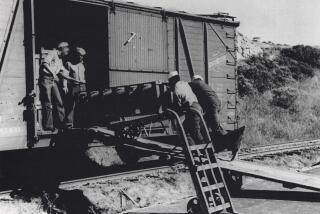Battleship’s Gunpowder Tests Confirmed
- Share via
WASHINGTON — The Navy on Monday acknowledged that the crew of the battleship Iowa was conducting “unauthorized experiments” with gunpowder charges in its 16-inch guns at the time of the April blast that killed 47 sailors.
The naval board investigating the explosion recommended that the officers and sailors involved in the tests be punished and that a complete inquiry into the improper experiments be conducted by the Navy’s inspector general.
But the Navy insisted Monday that the gunnery experiments had nothing to do with the explosion in Turret 2--an explosion that the Navy continues to maintain was probably caused by a suicidal sailor, Petty Officer Clayton M. Hartwig of Cleveland.
In response to complaints from members of Hartwig’s family, Ohio lawmakers have called for a congressional investigation of the blast and the Navy’s accusation that Hartwig caused it. Democratic Sens. John Glenn and Howard M. Metzenbaum and Democratic Rep. Mary Rose Oakar have asked the House and Senate Armed Services committees to conduct an independent inquiry.
The Navy’s four-month, $4-million investigation concluded that the catastrophic April 19 explosion was caused by a deliberate act of sabotage, “most likely” by Hartwig, who was the sailor closest to the breech of the 16-inch gun.
Based on testimony from hundreds of witnesses and on extensive laboratory tests, the Navy theorized that Hartwig inserted a homemade detonator between the first and second 110-pound bags of gunpowder in the gun, then ordered the rammer to compress the powder until the bags exploded.
The investigation found that the gun was loaded with five rather than the authorized six bags of black powder in a test designed to improve the range and accuracy of the 16-inch guns.
Officers also found that the gun was loaded with a high-explosive mixture known as D-846, which is only supposed to be used in smaller quantities than were used and only with lighter projectiles than the 2,700-pound shell loaded into the gun at the time of the blast.
Iowa Capt. Fred P. Moosally said he had not authorized and was not aware of the experiment with the powder and the shell in Turret 2. He said he thought the “reduced charge” that the crew was planning to fire meant six 55-pound bags of powder rather than the five 110-pound bags that exploded in the gun barrel.
The tests were supervised by Master Chief Petty Officer Steven P. Skelly, an Iowa crew member since 1987. Skelly--who was not in Turret 2 when the blast occurred--is considered to be one of the Navy’s top gunners, continually pushing the guns to their limit and trying new combinations of powder and projectile, Navy investigators said.
The gunnery experiments aboard the Iowa were informally directed by the Naval Sea Systems Command (NAVSEA) and the Naval Surface Warfare Center at Dahlgren, Va. Along with the FBI, those organizations conducted the laboratory tests that determined that the April blast could only have been caused by a deliberate act of sabotage and not by an accidental misfire.
A Navy spokesman said Monday that NAVSEA’s role in the Iowa investigation was not a conflict of interest because no other organization had the expertise to study an accident involving 16-inch naval guns.
Rear Adm. Richard D. Milligan, head of the team that investigated the Iowa disaster, found that Skelly had engaged in “unauthorized research and development” with the battleship’s main guns. He recommended that Skelly be disciplined for exceeding his orders and that Moosally be brought before an investigative panel to answer for his lack of crew supervision.
More to Read
Sign up for Essential California
The most important California stories and recommendations in your inbox every morning.
You may occasionally receive promotional content from the Los Angeles Times.













